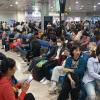Textiles, clothing, leather and footwear (TCLF) factories in HCMC have reported they are struggling to recruit new workers while existing staff keep quitting.
Thanh Cong Textile Garment – Investment – Trading JSC in Tan Phu District is in need of more than 1,000 workers.
The employees are to make up for those that have already submitted their resignation and to serve the company’s plan to expand 20 of its branches in various cities and provinces.
Yet the company has had trouble recruiting new employees unwilling to work on assembly lines and deal with the pressure of meeting product quality and quantity.
Nguyen Huu Tuan, the firm’s human resource manager, said the textile-garment sector is no longer attractive to laborers.
He said “a significant number” of staff at the company has either quit or is about to, without revealing the specific figure.
In most cases, those employees switch to work in other industries that can guarantee them higher salaries or move back to their hometown now that the living cost in the city has grown increasingly expensive.
“With a monthly income of VND8-9 million ($340-385), workers would not be able to afford living in Ho Chi Minh City,” said Tuan.
“The source of textile-garment workers on the market is now very limited and factories have been competing to recruit skilled laborers,” he said.
Tuan said that these days, many textile-garment factories cannot reach their capacity due to worker shortage.
Vinh Phong Footwear Co. Ltd in Hoc Mon District used to have more than 500 laborers before 2020 but these days, the figure has dropped to only 300.
“We just can’t find anyone [to recruit],” said Phan Thi Minh Thu, the company’s deputy director.
If the company could hire 50 skilled workers within just one week in the past, now it cannot get more than 10 within a month, she said.
Among the reasons is the quality of candidates, Thu explained, saying that in many cases they are nearly 40 and have already been rejected by other companies.
Facing a serious shortage of workers, Vinh Phong now has to suspend its plan to expand production and receive orders from new customers.
Taiwanese shoemaker Pouyuen Vietnam Co. Ltd., the biggest employer in HCMC, needs to hire 8,800 laborers after the city lifted Covid-19 lockdown last October.
But until now, the total number of staff has just reached 65 percent of its demand while there have been around 55-650 workers quitting each month so far this year.
The company said it has removed the recruitment target and limited the number of orders to align with the number of staff.
TCLF are the most labor-intensive industries in Vietnam’s economic sector.
The textile and garment industries use about two million employees, accounting for 25 percent of the entire processing and manufacturing industry. The corresponding figures for the leather industry are more than 1.4 million and over 18 percent.
Both industries have been facing a labor shortage in recent years and Covid-19 has made the situation even more serious.
According to the HCMC Center of Forecasting Manpower Needs and Labor Market Information (Falmi), the TCLF industries will use 390,000 – 437,000 laborers in 2022-2026.
On average, the industries are in need of 20,000-22,000 new employees each year but in recent years, have been able to hire a little over 1,000 per year, Falmi said.
Nguyen Thi Thuy, vice president of the Vietnam Textile and Apparel Union, said businesses under the union have received a lot of orders in the year to date but do not have enough employees to serve customers.
On average, those companies have been losing 10 percent of their workers each year, while facing difficulty in recruiting young staff.
Thuy said the average age of laborers at many textile-garment factories in HCMC is now 41-42.
They are committed because at that age, it would be very hard for them to apply for new jobs or they just simply stay to wait for their retirement pensions, she said.
She pointed out one of the reasons for such a labor shortage across TCLF industries is the lack of colleges and universities to train personnel for the field.
Le Duy Binh, managing director of Economica Vietnam, a Hanoi-based economic development agency, said the trend of laborers leaving TCLF industries for other sectors like electronics, services and tourism is “inevitable.”
He said in the coming time, TCLF would no longer be Vietnam’s strength and the country will have to restructure its economic growth model.
Looking at the experiences of other countries, the industries will have to shrink and stop relying too heavily on cheap labor as in the past, said Binh.
The shortage of resources and labor will force TCLF industries to invest in high-value-added stages like textile products, garment materials, and design.
Businesses in these sectors need to be well prepared to switch to the role of organizers rather than producers, like what Korean, Taiwanese and Chinese investors have been doing in Vietnam.
- Reduce Hair Loss with PURA D’OR Gold Label Shampoo
- Castor Oil Has Made a “Huge” Difference With Hair and Brow Growth
- Excessive hair loss in men: Signs of illness that cannot be subjective
- Dịch Vụ SEO Website ở Los Angeles, CA: đưa trang web doanh nghiệp bạn lên top Google
- Nails Salon Sierra Madre
 VnExpress News The News Gateway of Vietnam
VnExpress News The News Gateway of Vietnam




